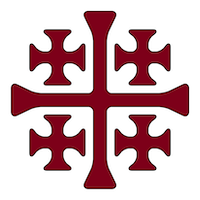As soon as President-elect Donald Trump had nominated Fox News host Pete Hegseth for secretary of defense, the legacy media unleashed a torrent of breathless stories about Hegseth’s “extremism” because he displays tattoos of the Jerusalem Cross and “Deus vult,” a Latin phrase associated with the Crusades.
The Associated Press reported that a fellow service member had flagged Hegseth as a possible “Insider Threat” due to “a tattoo on his bicep that’s associated with white supremacist groups.”
But are the tattoos really associated with white supremacists, or is that just what far-Left activists want you to think?
Retired Master Sgt. DeRicko Gaither, serving as the D.C. Army National Guard’s physical security manager in 2021, flagged the “Deus vult” tattoo to authorities before Joe Biden’s inauguration on Jan. 20, 2021, and as a result, Hegseth has said, he was told to stay home on Inauguration Day.
Gaither told The Associated Press that he researched Hegseth’s tattoos and “determined they had sufficient connection to extremist groups to elevate the email to his commanding officers.”
The AP uncritically quotes Heidi Beirich of the Global Project Against Hate and Extremism, who acknowledged that the tattoos “are associated with an expression of religious faith” but insisted that they “have also been adopted by some far-right groups and violent extremists.”
Beirich isn’t exactly a neutral source. She led the Southern Poverty Law Center’s Intelligence Project for eight years—a period during which the SPLC added Alliance Defending Freedom, a conservative Christian law firm that has won multiple cases at the Supreme Court, to a “hate map” that includes chapters of the Ku Klux Klan.
As I wrote in my book “Making Hate Pay: The Corruption of the Southern Poverty Law Center,” the SPLC uses this “hate map” to scare donors into raising money and to demonize its political opponents, suggesting they are driven by the same kind of hate as the Klan.
The SPLC often demonizes conservative Christians for dissenting from its LGBTQ agenda. But the organization also demonizes nonprofits that warn against the threat of radical Islam, a particularly salient fact for the AP to note when uncritically quoting the activist Beirich on the meaning of crusader symbols.
Even Beirich, however, noted that the meaning of the symbols “depends on context,” according to the AP.
Yet the AP didn’t provide any context explaining that the symbols aren’t white supremacist in nature.
Vice President-elect JD Vance condemned the AP’s report as “anti-Christian bigotry,” and he’s exactly right.
They're attacking Pete Hegseth for having a Christian motto tattooed on his arm. This is disgusting anti-Christian bigotry from the AP, and the entire organization should be ashamed of itself. https://t.co/tQxuD3RPlx
— JD Vance (@JDVance) November 15, 2024
The Jerusalem Cross
So what is the Jerusalem Cross?

The Jerusalem Cross consists of a large cross surrounded by four smaller Greek crosses, one in each quadrant of the larger cross. Godfrey of Bouillon, a key leader in the First Crusade, reportedly adopted the symbol.
According to Catholic News Agency, the cross predates the First Crusade (1096-1099), but became more common after the Kingdom of Jerusalem adoptedthe cross as its chief banner in the 1200s before Muslim forces expelled the crusaders in 1291. The cross remains the main insignia of the Latin Patriarchate of Jerusalem—the Latin Catholic diocese for the Holy Land.
After the end of the crusader era, pilgrims carried an image of the Jerusalem Cross as they made the journey to the City of David to walk in the footsteps of Jesus. Pilgrims often get a tattoo of the cross after completing a pilgrimage to Jerusalem, in a tradition dating back more than 700 years.
Hegseth personally has gone to Jerusalem to walk in Jesus’ footsteps, and it seems plausible he received the cross tattoo after one such journey.
Catholic News Agency gives multiple interpretations of the five crosses. They may represent the four Gospel writers—Matthew, Mark, Luke, and John—plus Jesus at the center. They may represent Jesus’ five wounds during the Crucifixion: the nail piercings in his hands and feet and the spear piercing in his side. The crosses also may represent the spread of the Gospel to the four corners of the earth.
Father David Grenier is a Catholic priest and member of a religious order called the Holy Land Franciscan Friars, which uses the Jerusalem Cross as its symbol. Grenier told Fox News Digital that he isn’t familiar with the cross being used to represent Christian supremacy or white supremacy. Rather, he said, it represents the message of salvation spreading to all people across the globe.
What Is ‘Deus Vult?’
“Deus vult” is a Latin phrase meaning, “God wills it.” It became a rallying cry for European Catholics in the First Crusade, although Christians throughout history—including the Puritans as well as Catholic chivalric orders—also adopted the phrase as an expression of divine Providence.
Although white nationalists have occasionally adopted the phrase, medieval scholars have condemned this as an abuse of history.
The phrase “Deus vult” has much more to do with Providence and the Crusades than it has to do with any racist movement in the U.S. today.
In Defense of the First Crusade
The Crusades have gotten a bad reputation. A group of Western Christians traveled to Jerusalem in 1999 on the 900th anniversary of the First Crusade, to apologize to Muslims for the wars, suggesting that the Crusades were a form of European colonization. Many today see the Crusades as a prefiguring of America’s bungles in the Middle East, particularly the invasion of Iraq in 2003.
Yet, as sociologist Rodney Stark pointed out in his excellent book “God’s Battalions: The Case for the Crusades,” the truth is far thornier—and the pilgrims who led the First Crusade had a virtuous cause.
Pope Urban II called for a crusade on Nov. 27, 1095. In his passionate speech, Urban described how roving bands had attacked pilgrims on the road to Jerusalem, raping women and murdering civilians who planned only to walk in the footsteps of Jesus.
Let’s not forget the reason why the Crusades were necessary in the first place. The entire Roman world had become Christian by the 400s, but Islam spread by the sword and Caliph Umar captured Jerusalem in the 600s. Many Muslim rulers allowed Christian pilgrims to the holy city, but violent attacks increased in the late 1000s.
No king volunteered to lead the First Crusade, so noble families and peasants took up the charge. The Byzantine Emperor Alexius I Comnenus had asked Pope Urban for help in fighting the Seljuk Turks, who were encroaching on his territory. When the crusaders arrived, Alexius refused to lead the army. He did provide key assistance, but the crusaders held a grudge against him, a grudge that would lead to the Third Crusade sacking the city of Constantinople.
Stark, the sociologist, argues that the ragtag band of peasants and lesser nobles fought the First Crusade on the typical terms of war for the period. Modern scholars condemn the crusaders for massacring the population of Jerusalem when the city didn’t surrender, but Stark says this reveals a modern bias. The later Muslim conqueror Saladin also massacred the populations of cities that didn’t surrender during sieges, and he only spared Jerusalem in 1187 because the later crusaders did surrender the city to him.
Although modern critics say the Crusades represented an early period of European colonialism, with Europeans plundering the land for profit, Stark notes that the crusader period actually saw European monarchs sending vast sums of money to the crusader states in order to maintain them.
The Crusades ultimately failed, and later crusades devolved into tragedy and farce. Yet after the Sept. 11, 2001, terrorist attacks, the Crusades resonate with Americans who see the threat of radical Islam.
The Modern Salience of the Crusades
The ideology that inspires the Islamic State, or ISIS, and its surviving terrorist branches preaches military conquest to bring all the world under the control of Islam. This ideology echoes the early Muslim conquests of Israel and North Africa.
The 9/11 attacks illustrated the fact that, even after the collapse of the Soviet Union, America and its ideals still have clear enemies across the world. Since Islam is a religion of law, interpretations of Islamic law vary widely, and many imams teach versions of Islam that are compatible with American freedom.
However, Americans must remain alert to the fact that many imams teach strict interpretations of Islamic law that deprive women of rights (as we see in Iran and Afghanistan), teach hatred for Jews and Christians, and teach a form of deception called taqiyya that may cloak nefarious purposes.
The threat of radical Islam has made identification with the crusaders a hot topic on the Right, and this may be one reason Hegseth got a “Deus vult” tattoo.
Unfortunately, many on the Left have dismissed the threat of radical Islam, and the Southern Poverty Law Center brands groups such as the Center for Security Policy and the David Horowitz Freedom Center (which warn about this threat) as “anti-Muslim hate groups.”
Partnering with the Council on American-Islamic Relations, which bills itself as the largest Muslim public policy nonprofit in the U.S. but has historic ties to a terrorist-funding network, the SPLC seeks to silence those who condemn radical Islam.
Beirich—whose current nonprofit follows the lead of the SPLC, where she long served as director of the project that releases the “hate map” demonizing conservatives and Christians—has both a track record of condemning conservatives and an incentive to twist Christian symbols into signs of “hate.”
The fact that The Associated Press uncritically cited Heidi Beirich in its coverage on these issues reveals its anti-Christian bias and should expose this report for the farce that it is.

Tyler O’Neil is managing editor of The Daily Signal and the author of two books: “Making Hate Pay: The Corruption of the Southern Poverty Law Center,” and “The Woketopus: The Dark Money Cabal Manipulating the Federal Government. Reproduced with permission. Original here.
